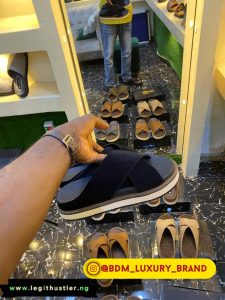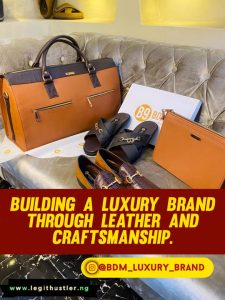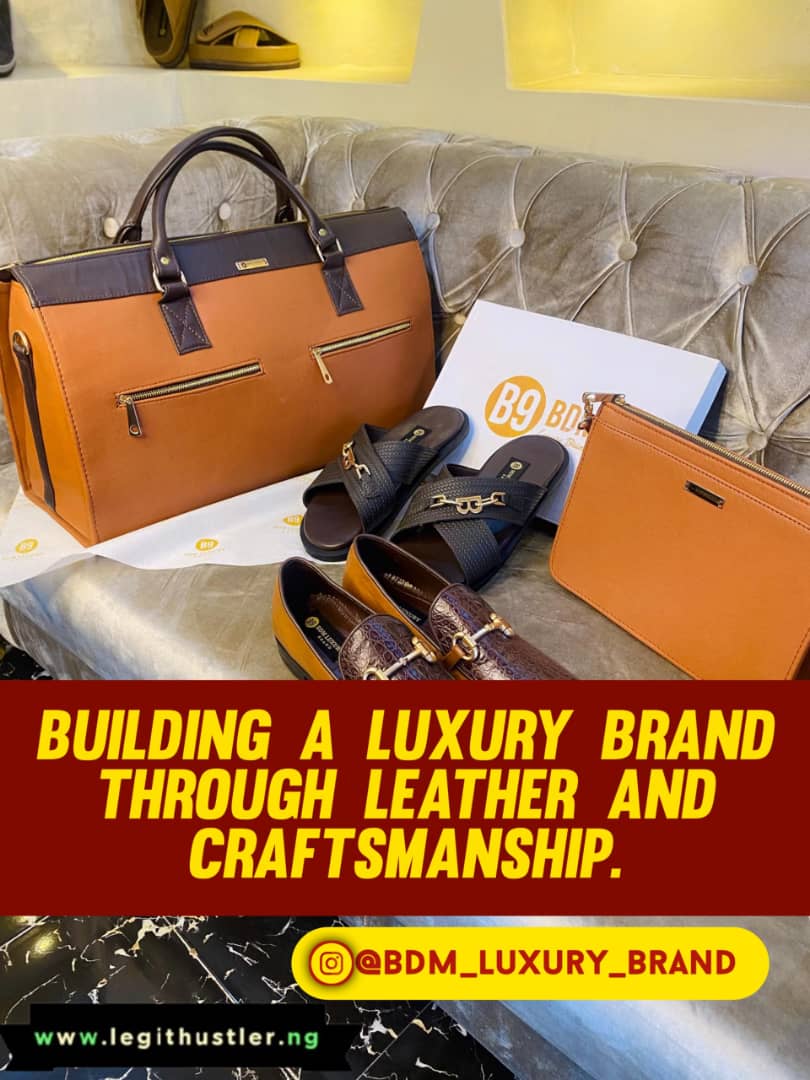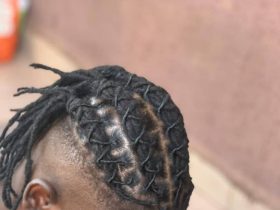Building a luxury brand through leather craftsmanship
In an exclusive insight, the CEO of Billion Dollar Mindset (BDM) luxury brand revealed the driving force behind his decision to venture into leather craftsmanship. “While most people focus on consumption, I chose to disrupt this narrative by becoming a producer,” he explained.
Motivated by a desire to provide consumers with more choices and alternatives, the CEO embarked on a journey to create high-quality, durable leather products. Today, BDM luxury brand boasts an impressive portfolio of classic leather goods, including footwear, bags, and belts.
By shifting the focus from consumption to production, the CEO of BDM luxury brand has successfully carved a niche for himself in the luxury leather market, offering discerning consumers unparalleled quality and craftsmanship.
Considerations before starting a luxury brand
1. Location
Your location plays a crucial role in determining the type of products to focus on. Understanding local market demands and preferences is essential to creating products that resonate with your target audience.
2. Competition
While the craftsmanship business may have fewer competitors, the market is not devoid of competition. To stand out, producers must continually innovate and introduce new styles and packages to cater to diverse consumer preferences. Achieving global recognition is possible when your products offer value commensurate with their price.
3. Inflation
Inflation can significantly impact businesses, causing fluctuations in product prices. To mitigate this, consider buying tools and materials in bulk, even during off-peak market periods. This strategic approach enables you to maximize profits when prices increase.
4. Customer Relationship
In a market dominated by imported goods, convincing customers of the superiority of your products is vital. Foster strong relationships with your customers by highlighting the unique value proposition of your products, emphasizing quality, and providing exceptional customer service. This will enhance productivity, customer loyalty, and ultimately, income generation.
How to remain relevant and unique
Overcoming Production Challenges
In the world of craftsmanship, production is fraught with numerous challenges. Amidst these obstacles, maintaining your brand’s standards is paramount. This unwavering commitment to quality ensures that your products consistently meet the expectations of discerning customers.
The Price-Quality Paradox
While some customers may initially balk at the price of your products, the superior quality of your materials will ultimately win them over. Although high-quality materials may increase production costs, they guarantee a loyal customer base. Customers who value excellence will return time and again, recognizing that the investment in your premium products is well worth the cost.
Other relevant craftsmanship to make massive profits
Beyond leather craftsmanship, numerous other lucrative crafts can generate substantial income. One such opportunity is establishing a Clothing Brand, encompassing various niches such as:
Clothing Brand Niches
1. Native Wears: Creating traditional attire with a modern twist.
2. Formal Wear: Designing bespoke suits, shirts, and pants.
3. Couture: Offering custom-made clothing for special occasions.
Strategic Advice
To succeed in the clothing brand industry:
1. Focus on a Niche: Initially concentrate on a specific area, ensuring expertise and reputation.
2. Uniqueness: Differentiate your brand through innovative designs, quality, and exceptional customer service.
3. Expansion: Gradually expand your product line or services, maintaining consistency and excellence.
By embracing these strategies and exploring various craftsmanship opportunities, entrepreneurs can establish thriving businesses and capitalize on the growing demand for unique, high-quality products.
How much capital is required for starting a leather craftsmanship

Acquiring Essential Skills and Knowledge
Before investing capital in your leather craftsmanship business, it’s crucial to acquire the necessary skills and knowledge. Without proper training, you risk facing significant challenges and potential failure in the long run. Alternatively, you may need to hire staff to perform tasks, which can increase overhead costs.
The time required to acquire basic skills varies depending on individual differences and capacity. However, with dedication and consistent effort, you can gain a solid foundation in leather craftsmanship within six months.
Essential Tools and Equipment
To establish a leather craftsmanship business, you’ll need to invest in essential tools and equipment. The two most expensive items are:
1. Sewing Machine: A heavy-duty sewing machine designed for leather.
2. Filling Machine: A machine used for filling and shaping leather products.
Other necessary tools include:
– Shoe last
– Hammer
– Scissors
– Additional specialized tools
Startup Costs
The initial investment required to start a leather craftsmanship business from home is approximately ₦500,000. This cost covers essential tools, equipment, and initial materials.
Renting a Store
If you prefer to operate from a physical store, the startup costs will be higher, depending on factors such as:
– Location
– Store size
– Rental fees
– Equipment and furniture requirements
Keep in mind that these costs are estimates, and your actual expenses may vary.
Tools and Materials
In addition to the sewing machine and filling machine, several other tools are necessary for leather craftsmanship:
1. Scissors: Three pairs of high-quality scissors for cutting leather accurately.
2. Hammers: For shaping, flattening, and smoothing leather.
3. Punches: Used to create holes for stitching, rivets, or other hardware.
4. Cylinders for Gumming: For applying adhesive to leather surfaces.
5. Shoe Last: A crucial tool for shoe making, available in various sizes to accommodate different foot shapes and sizes.
The Importance of Shoe Last
Shoe last is an indispensable tool in shoe making, enabling craftsmen to create footwear that fits perfectly. Even when a customer is not present, shoe last allows craftsmen to create custom-fit shoes. While it’s possible to purchase multiple shoe lasts in different sizes, experienced craftsmen can use a single last to create various sizes of footwear, reducing costs and increasing efficiency.
How to get initiative and advance creativity
Creativity is an innate talent, but it can be further nurtured and inspired by exploring the work of globally recognized luxury brands like Gucci and Fendi. Studying their designs, techniques, and attention to detail can broaden your creative horizons.
Embracing Originality and Innovation
However, it’s essential to remember that inspiration should not translate to imitation. Instead, strive to create unique and original designs that reflect your personal style and brand identity.
Experimenting with New Styles and Techniques
Don’t be afraid to push boundaries and try new approaches in your production. There are customers eager to discover innovative and exclusive designs. By taking calculated risks and exploring fresh ideas, you can differentiate yourself from the competition and establish a loyal client base.
Sourcing for materials/tools
For artisans and craftsmen in Nigeria, several markets offer a wide range of materials for leather craftsmanship. The most popular options include:
Major Markets
1. Lagos: Known for its vast array of materials, Lagos is a hub for craftsmen.
2. Onitsha: A major market in the eastern region, offering a variety of materials.
3. Aba: Another significant market in the eastern region, providing ample options.
Pricing and Location Considerations
Prices for materials vary across markets, depending on location. To minimize expenses and stay within budget, consider the following:
– Proximity: When starting small, purchase materials from nearby markets to reduce transportation costs.
– Compare Prices: Research prices across different markets to find the best deals.
– Quality: Prioritize material quality to ensure durability and excellence in your craftsmanship.
By sourcing materials strategically, you can optimize your budget, maintain quality, and drive the success of your leather craftsmanship business.
How profitable is a luxury brand?
Every business has the potential to be profitable, depending on the individual managing it. A luxury brand, in particular, is driven by numbers and prioritizes high-volume sales.
Scaling Up with Mass Production
To achieve significant profits, luxury brands often engage in mass production. This approach requires purchasing materials in bulk, which can lead to substantial cost savings. As the quantity of materials increases, the cost per unit decreases, resulting in higher profit margins after sales.
Financial Stability in Leather Craftsmanship
One of the advantages of establishing a leather craftsmanship brand is its ability to maintain capital. Unlike other businesses, leather craftsmanship does not typically deplete initial investments. Instead, it may affect profit margins if subpar materials are used. By using high-quality, reliable materials, entrepreneurs can ensure the long-term financial stability of their leather craftsmanship business.
Branding and marketing

Branding is a deliberate choice that reflects the owner’s vision and product identity. Effective branding techniques include:
1. Labeling or Metal Tagging: Adding a label or metal tag to products can elevate the brand’s image and create a lasting impression.
2. Avoid Overpackaging: Excessive packaging can detract from the brand’s value and create unnecessary waste.
Evolving Branding Efforts
As your business grows, your branding efforts should adapt to changing trends and customer preferences. Focus on:
1. Staying Up-to-Date with Industry Trends: Continuously monitor industry developments to ensure your brand remains relevant.
2. Building a Strong Online Portfolio: Showcase your products and services through a professional online portfolio.
3. Leveraging Social Media: Utilize platforms like TikTok, Facebook, Twitter, and Instagram to promote your brand and engage with customers.
Maximizing Marketing Efforts
To reach a wider audience:
1. Balance Online and Offline Marketing: Allocate resources effectively between online and offline marketing strategies.
2. Harnessing TikTok’s Algorithm: Leverage TikTok’s algorithm to increase post visibility and attract new customers.
3. Physical Stores and Trust-Building: Establish a physical store to build trust with online customers and provide easy access to products.
By implementing these strategies, businesses can strengthen their brand identity, expand their customer base, and drive long-term growth.
Mistakes and Challenges
1. Relying on Personal Network: Don’t assume friends and family will be your primary customers. Focus on building a broader client base.
2. Lack of Skills and Knowledge: Acquire essential skills and knowledge before launching your luxury brand to avoid frustration and failure.
3. Ineffective Order Management: Poor order management can lead to financial losses and decreased profitability. Develop a system to manage orders efficiently.
4. Limited Creativity: Surround yourself with a talented team to bring innovative ideas and help your brand stand out.
5. Using Subpar Materials: Ensure products are made from authentic, high-quality materials. Using fake or outdated materials can damage your brand’s reputation.
6. Unpreparedness for Stress: Be willing to handle the stress and pressure that come with building a luxury brand. Resilience and adaptability are crucial for overcoming obstacles and achieving success.












Leave a Reply